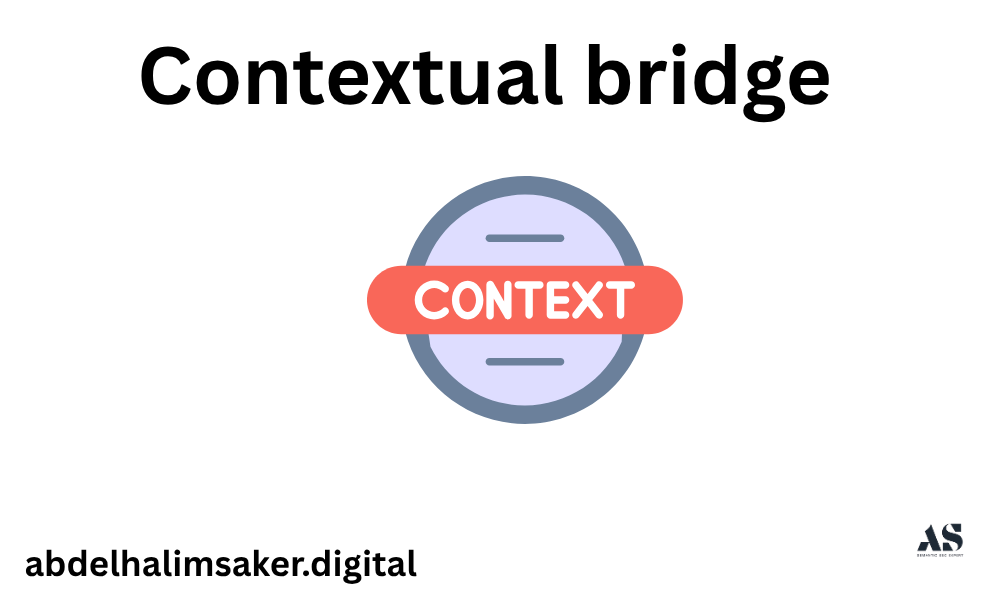
A contextual bridge is a connective structure that links two related contexts within or across web pages. It can exist with or without hyperlinks and serves as a semantic pathway that guides both users and search engines from one meaning context to another.
In semantic SEO, contextual bridges ensure continuity of meaning, entity connection, and intent reinforcement across a content ecosystem. They help Google recognize that different pieces of content belong to a shared topical field.
Types of Contextual Bridges
Contextual bridges appear in two primary forms: linked bridges and linkless bridges. Both carry semantic weight but operate through different mechanisms.
| Type | Mechanism | Example | Semantic Function |
|---|---|---|---|
| Linked Bridge | Uses hyperlinks to connect related pages | “Learn more in our guide on Semantic Distance.” | Explicit topical connection |
| Linkless Bridge | Uses shared entities, attributes, or predicates | “As discussed in semantic clustering theory…” | Implicit contextual connection |
Linked Contextual Bridges
Definition:
A linked contextual bridge is a visible hyperlink that connects two semantically adjacent pages within the same domain.
These bridges serve both navigation and meaning reinforcement functions. Google follows internal links to crawl pages and uses their anchor text to interpret semantic relationships.
Example:
- In an article about Query Semantics, linking to Semantic Distance creates a bridge based on shared contextual relevance.
- Anchor text such as “how search engines measure similarity” defines predicate direction and intent alignment.
Semantic effect:
- Strengthens topic cohesion.
- Transfers link equity and context weight.
- Improves semantic connectivity between pages.
Optimal traits of a linked bridge:
- Descriptive, predicate-rich anchor text (e.g., “defines,” “connects,” “improves”).
- Proximity between anchor and core entities.
- Logical flow that anticipates user information need.
Linkless Contextual Bridges
Definition:
A linkless contextual bridge connects topics without explicit hyperlinks. Instead, it relies on shared entities, predicates, and contextual similarity.
These bridges are built through co-reference — the repetition or mutual referencing of entities and ideas across multiple documents.
Example:
A page about macro semantics and another about semantic distance may share repeated entity mentions such as BERT, Google NLP, and context vectors.
Even without hyperlinks, Google’s NLP and co-occurrence models recognize that both pages operate within the same semantic neighborhood.
Mechanism:
- Entity overlap: Repetition of core entities (e.g., “Semantic SEO,” “BERT,” “Google”).
- Attribute alignment: Shared adjectives or relational descriptors (e.g., “contextual,” “topical,” “hierarchical”).
- Predicate recurrence: Use of similar verbs (e.g., “connects,” “defines,” “measures”).
Linkless contextual bridges are particularly useful in topical maps, where multiple nodes (pages) share semantic gravity through implicit entity relations.
How Contextual Bridges Strengthen Semantic Signals
Contextual bridges strengthen semantic signals by creating pathways of meaning that help Google interpret entity continuity, topic depth, and intent coherence.
Search engines use these bridges to map the knowledge domain of a website, connecting micro-level text meaning to macro-level topical identity.
1. Reinforcement Through Co-reference
Co-reference occurs when multiple pages mention the same entities or phrases referring to the same conceptual object.
Google’s NLP models identify these patterns to group related pages into semantic clusters.
Example:
- Page A: “Semantic distance measures contextual closeness.”
- Page B: “Search engines calculate contextual closeness using semantic distance.”
Here, both pages reference “semantic distance” and “contextual closeness.” Even if they are not linked, Google detects co-referential meaning.
Effect:
- Strengthens entity recognition.
- Reduces semantic ambiguity.
- Increases contextual probability within the domain.
Predicates (verbs) define how entities relate to one another. When the same predicates appear across multiple contexts, they form consistent relational meaning.
Example:
- Page A: “BERT improves context understanding.”
- Page B: “Schema improves semantic interpretation.”
Both use the predicate “improves”, signaling that the domain focuses on optimization and enhancement — a predicate-level pattern.
Search engines use these shared predicates to infer sitewide intent.
Effect:
- Builds semantic consistency.
- Connects sentences into a larger meaning graph.
- Reinforces brand-level topical direction.
3. Reinforcement Through Consistent Attributes
Attributes describe qualities or relationships of entities (e.g., “contextual,” “hierarchical,” “semantic”).
Repeated attributes across content clusters act as semantic glue — uniting different pages under the same conceptual identity.
Example:
- Page A: “Contextual hierarchy defines macro-to-micro relationships.”
- Page B: “Contextual bridges connect adjacent topics.”
Both share the attribute “contextual,” indicating topical proximity.
Effect:
- Reduces semantic distance.
- Signals topical cohesion.
- Helps Google’s vector space models group related concepts.
Building Effective Contextual Bridges
Building contextual bridges requires designing semantic pathways that connect related entities and topics both explicitly (through links) and implicitly (through shared meaning).
The goal is to make your content machine-readable and human-coherent by aligning macro structure (clusters) with micro meaning (sentence-level relations).
1. Identify Semantically Adjacent Pages
Semantically adjacent pages share overlapping entities, attributes, or intents.
Before creating a bridge, analyze your topical map to identify which nodes naturally connect.
Example adjacency:
- What Is Query Semantics ↔ How Search Engines Use Semantic Distance
- Macro vs Micro Semantics ↔ Contextual Hierarchy
Use tools such as co-occurrence analysis or entity graphs to measure similarity.
Semantic rule:
- Only bridge pages with low semantic distance (conceptual proximity).
- Avoid bridging unrelated topics (e.g., semantic SEO with link building).
2. Use Predicate-Rich Anchor Texts
Anchor texts are micro-bridges. Their phrasing determines how meaning flows between pages.
Strong predicates make anchors semantically directional — they tell Google what relationship exists.
Examples:
- “Learn how semantic distance defines context understanding.”
- “See how contextual hierarchy structures topic flow.”
Avoid generic anchors like “click here” or “read more.” They provide no semantic direction.
| Anchor Type | Predicate | Semantic Value |
|---|---|---|
| “Learn how context defines hierarchy” | defines | High |
| “Click here for more info” | none | Low |
| “Guide to related topics” | relates | Medium |
3. Maintain Logical Flow Across Bridges
A contextual bridge must feel natural within discourse.
The preceding and following sentences should frame the linked topic logically, maintaining discourse integration.
Example:
“Semantic distance measures conceptual proximity between entities.
To understand how these relationships are organized, explore contextual hierarchy.”
Here, the bridge occurs in a meaningful transition, not an unrelated tangent.
4. Reinforce with Linkless Signals
Even after adding explicit bridges, strengthen the relationship through implicit signals like:
- Repeated entities (e.g., “semantic,” “contextual,” “hierarchy”).
- Shared attribute modifiers.
- Similar predicate use (“connects,” “defines,” “guides”).
This ensures that both linked and linkless bridges converge semantically, amplifying overall context cohesion
5. Schema-Level Reinforcement
Structured data can represent contextual bridges using about, mentions, or sameAs properties.
Example (JSON-LD):
{
"@context": "https://schema.org",
"@type": "Article",
"headline": "What Is a Contextual Bridge",
"about": ["Semantic SEO", "Contextual Linking", "Entity Relationships"],
"mentions": [
"https://example.com/query-semantics",
"https://example.com/contextual-hierarchy"
]
}
This structured representation helps Google interpret the bridge’s purpose and validate entity connections across your site.
Measuring the Impact of Contextual Bridges
To evaluate how well contextual bridges perform, measure both technical signals (crawl flow, link graphs) and behavioral metrics (engagement depth, dwell time).
1. Improved Crawl Flow
Contextual bridges create optimized navigation pathways for crawlers.
Internal links reduce crawl depth and improve indexation rate.
Metrics to track:
- Crawl depth (should decrease).
- Indexed pages per crawl cycle (should increase).
- Link equity distribution (via PageRank or LinkFlow metrics).
Effect:
Crawlers spend less time discovering pages because bridges provide efficient semantic pathways.
2. Increased Engagement Depth
Contextual bridges also improve user experience metrics by guiding readers through meaning-connected content.
Behavioral signals:
- Session duration: users stay longer exploring connected topics.
- Pages per session: rises when bridges guide curiosity paths.
- Bounce rate: decreases when users find relevant continuation points.
Example:
A reader learning about Query Semantics is naturally inclined to continue with Semantic Distance or Contextual Hierarchy.
3. Context Reinforcement and Entity Association
Google measures context reinforcement through co-occurrence and embedding similarity.
When multiple pages share bridges and overlapping entities, the domain gains stronger entity–context association in the Knowledge Graph.
Observable effects:
- Improved keyword clustering visibility.
- Better ranking for semantically connected queries.
- Enhanced topical authority perception.
Data points:
- Increase in impression overlap across related pages.
- Higher semantic similarity scores in NLP tools (e.g., cosine similarity).
4. Impact on Topical Authority
Contextual bridges act as neurons in your topical network.
Each bridge improves knowledge graph density, creating a tightly integrated context web.
Authority gain mechanism:
- Bridges reduce semantic isolation.
- Shared predicates and attributes increase topic depth.
- Repeated co-reference builds Google-trusted continuity.
Example domain pattern:
- What Is Semantic SEO ↔ How Google Understands Entities ↔ Predicates and Context Weight ↔ Contextual Bridges
This chain reflects contextual logic — where every page connects logically to another through meaning, not just links.
Practical Example: Contextual Bridge in Action
Consider a cluster about Semantic Understanding in SEO with pages such as:
- Query Semantics
- Semantic Distance
- Predicates and Context Weight
- Contextual Hierarchy
To build bridges:
- Use linked anchors:
- “As semantic distance explains, entities close in meaning rank together.”
- Use linkless bridges:
- Repeat entities “semantic,” “context,” “Google NLP,” and predicates “connects,” “defines,” “measures.”
The network created through these bridges allows Google to perceive the cluster as a cohesive semantic entity.
Effect:
- Improved crawl efficiency.
- Stronger ranking for related terms.
- Higher internal topical authority.
Key Optimization Checklist
| Optimization Aspect | Implementation Example | Effect |
|---|---|---|
| Linked bridges | Anchor text: “how semantic distance defines proximity” | Improves crawl & semantic clarity |
| Linkless bridges | Shared entities like “context,” “BERT,” “Google NLP” | Reinforces topic adjacency |
| Predicate repetition | Use “connects,” “defines,” “links” across pages | Builds contextual alignment |
| Schema reinforcement | mentions property in JSON-LD | Adds machine-readable bridges |
| Discourse integration | Logical sentence transitions | Improves readability and meaning flow |
Core Takeaways
- Contextual bridges connect meaning contexts through links or semantic overlap.
- They function as information conduits that strengthen both human understanding and machine interpretation.
- Linked bridges work through hyperlinks and anchor texts.
- Linkless bridges work through shared entities, predicates, and co-referential meaning.
- Their combined use increases semantic integrity, crawl flow, and context reinforcement, ultimately amplifying topical authority.
